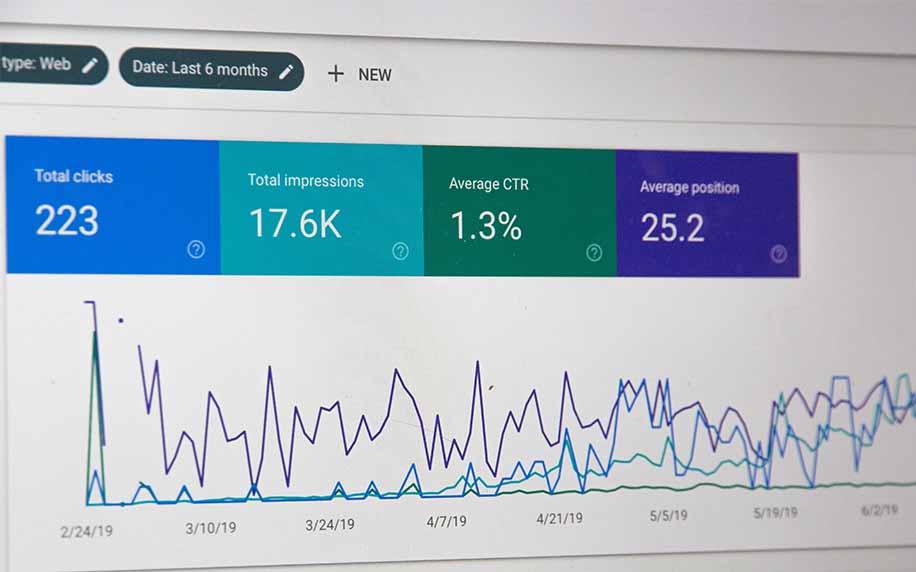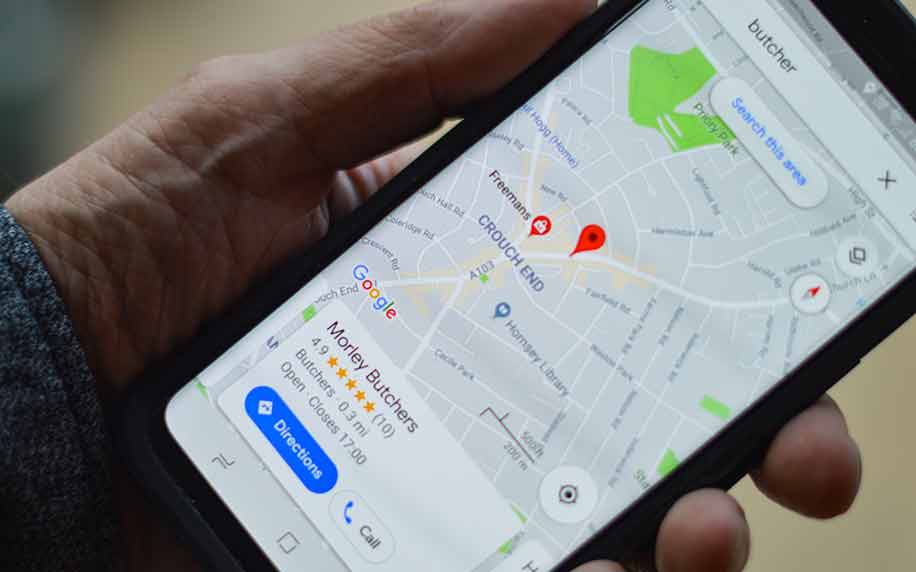For many website owners, organic traffic drops are a scary prospect. SEO is a complex game, and falling numbers of users are obviously worrying from a business perspective.
Afterall, fewer users means less revenue.
While some kinds of drops in traffic can indicate a serious problem, others can be explained by things as simple as the weather, or the time of year. So how do you know when it’s time to panic?
There are a number of ways to go about this, including full-blown technical SEO audits, or deep dives into your Google Search Console data. However, these are time consuming, and complex processes.
As such, it’s helpful if you have a broad idea of what the problem is before you start digging deeper.
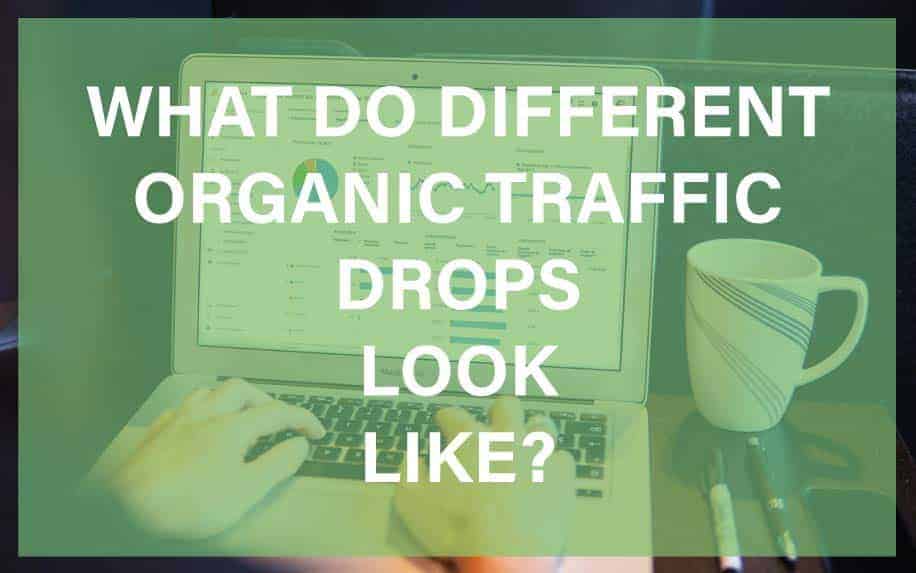
The key here is understanding the different kinds of traffic drop graphs.
Table of Contents
When the Tide Goes Out: Demystifying Organic Traffic Drops
Have you ever stared at your website analytics, only to see a chilling sight: your organic traffic plummeting faster than a meteor through the atmosphere? Don’t worry, you’re not alone. Organic traffic drops are a frequent foe in the web’s ever-shifting landscape, sending shivers down the spines of even the most seasoned digital warriors.
But before we grab our torches and pitchforks, let’s demystify this digital beast.
A. Defining the Drop:
An organic traffic drop is a significant and sustained decline in the number of visitors your website receives from search engines like Google, Bing, and Yahoo. Unlike paid traffic sources like ads, organic traffic comes in organically, meaning people find your website through natural search results, drawn by compelling content and relevant keywords.
B. The Chilling Importance:
So, why should a drop in these organic “guests” matter? It’s like discovering a leak in your boat – a small dip might be manageable, but a sustained decline can sink your entire digital voyage. Here’s why:
- Revenue Erosion: Organic traffic is often a key driver of leads, sales, and ultimately, revenue. A drop can translate to fewer conversions, missed opportunities, and a shrinking bottom line.
- Brand Visibility Erosion: Your website’s ranking in search engine results pages (SERPs) is directly linked to organic traffic. A drop can mean you’re fading into the abyss of internet obscurity, where potential customers struggle to find you.
- SEO Confidence Blow: Organic traffic is a marker of your website’s health and SEO standing. A drop raises red flags, eroding confidence in your digital strategy and leaving you scrambling for answers.
But remember, panic is not a winning strategy. By understanding the reasons behind the drop and employing the right tactics, you can transform it from a terrifying shipwreck into a thrilling treasure hunt, uncovering areas for improvement and propelling your website back to the top of the SERPs.
So, grab your navigational tools, fellow adventurer. In the upcoming sections, we’ll dive deep into the causes of organic traffic drops, unveil practical solutions, and equip you with the knowledge to chart a course towards a thriving online presence. Are you ready to turn the tide and reclaim your web dominion?
Traffic Drop Graphs
When you notice your traffic figures sliding, your first port of call is assessing the shape of the curve. Surprisingly, this can tell us a lot about what’s going on with a site. Helpfully, Google has placed these into four categories for us:
- Site Level Issues & Manual Actions – Where your traffic takes a sudden dive and stays down.
- Seasonality – Where your organic traffic drops and rises over a given time period,
- Page Level Issues, Algorithm Changes and Disruption – Where traffic drops significantly, but in a less straightforward pattern,
- Reporting Glitches – Where there is a sudden drop which quickly recovers.
Helpfully, Google has even provided a few diagram to help illustrate this point:
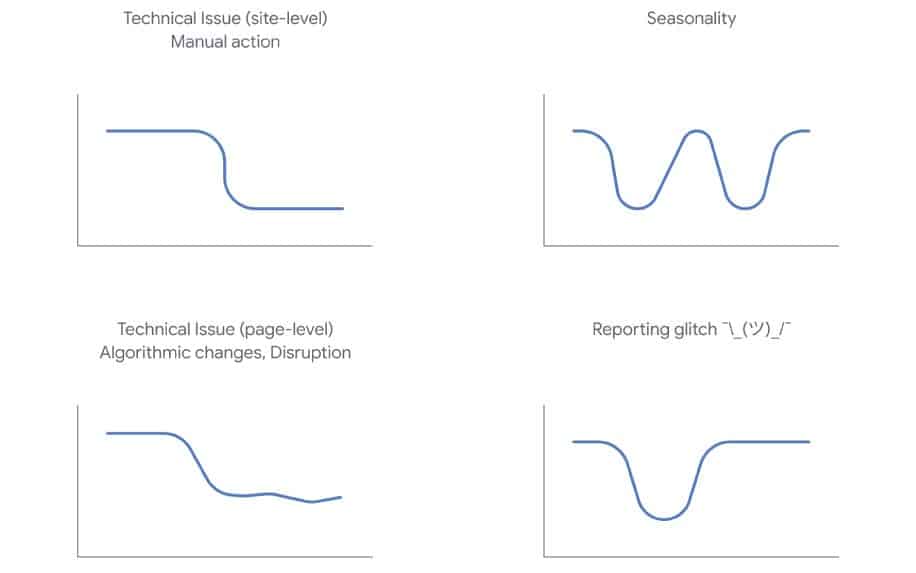
Of course, these are illustrative examples. In the real world, things aren’t quite so clear cut. Still, this is a useful resource for deciding what the most likely culprit behind organic traffic drops is.
Why Has My Organic Traffic Dropped?
To give more context to what each of these traffic trends means, let’s take a look at some of the likely causes for each of the main kinds of organic traffic drops.
Site Level Issues
Site level issues are problems which prevent Google from ranking your entire site highly. These can be crawlability issues like broken links and improper sitemaps, or they might be a result of penalties incurred for blackhat SEO strategies.
Page Level Issues
This is something which is wrong with a specific page or a number of pages, which causes them not to be ranked correctly. Examples include under optimisation issues, broken media, such as image files, or poor load speeds on individual pages.
Algorithm Changes
Algorithm changes are very hard to pin down these days, as Google is constantly tweaking its formulae. Still, this can have a major impact on your traffic, so when you notice a drop, it’s worth reading up on recent algorithm changes.
Seasonality
This is a case of supply and demand. For example, if you sell Christmas trees, you’re almost certainly going to notice a drop in traffic around the start of the year.
Disruption and External Factors
Typically, this means that you’ve been bested by your competitors, and lost rankings. Assess your Search Console data, or a traffic analysis tool like Semrush to see if you’ve begun slipping in the rankings, and then figure out what competitors are doing that you’re not.
Reporting Glitches
Sometimes Google Analytics just gets things wrong. If your traffic drops or spikes suddenly, and then returns to normal, there probably isn’t anything to worry about.
What to Do About Organic Traffic Drops
With an understanding of the broad category of issue you’re looking for, it’s time to start identifying the more specific causes of your organic traffic drops. You can essentially do this in three steps.
1. Adjust Your Time Frame
Set your analytics to show data as far into the past as possible, and see if you can notice any seasonal changes. If your traffic drops around the same time every year, or even every month, then the problem is likely decreased demand for your content.
If this is the case, you can start thinking about how to create more evergreen content. If not, carry on to step two.
2. Look for Site-Wide Issues
Next, it’s time to start looking for sitewide issues. First, check out your Google Search Console data, and see if you can identify any manual actions penalties or coverage issues. If these are detailed, then resolve them and verify in Search Console.
If not, move onto the next step.
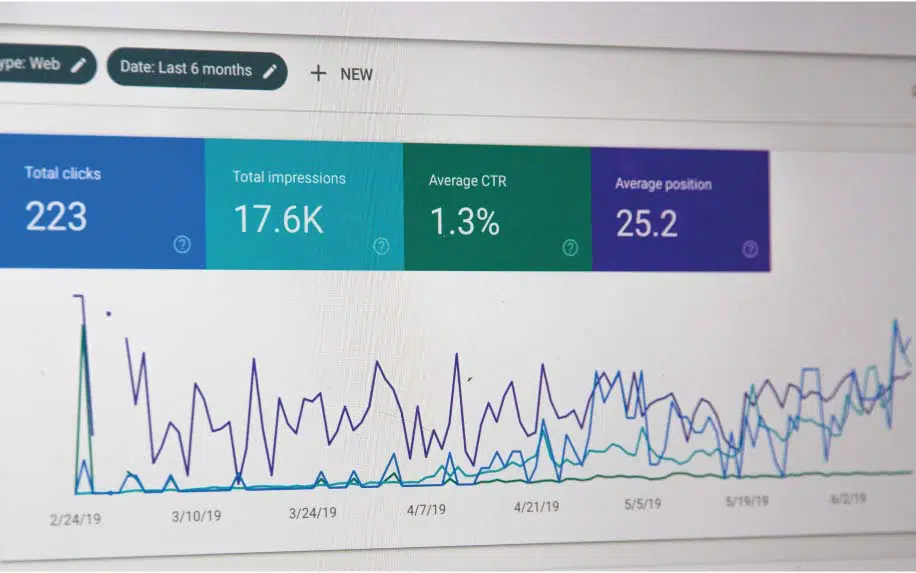
3. Look for Page-Level Trends
If it doesn’t seem like the problem is site wide, head back to Google Analytics, and navigate to Acquisition>Landing Page. Start diving into each of your top landing pages to see where organic traffic drops have occurred.
The key here is to look for trends. For example, are they all pages in the same sub-folder, or pages which you have recently edited? Then, use a technical SEO audit tool to assess what specific problems might be undermining their ranking potential.
Pre-emptive Measures to Shield Your Organic Traffic
Imagine stepping onto a stormy sea, prepared with a sturdy vessel and a seasoned crew. That’s the essence of pre-emptive measures when it comes to organic traffic drops – proactive strategies to weather the digital storms and safeguard your website’s performance. So, let’s raise the sails and explore these proactive tactics:
1. Monitor the SEO Landscape:
- Stay informed: Actively follow SEO news and updates from Google and other search engines. Subscribe to industry blogs and publications to stay ahead of the curve.
- Track competitor strategies: Analyze your competitors’ organic traffic trends, content updates, and backlink profiles. Identify and adapt to their successful strategies before they impact your own rankings.
- Utilize SEO tools: Leverage web analytics platforms like Google Search Console and Ahrefs to track your website’s health, keyword rankings, and backlinks. Regularly monitor these metrics for early signs of potential issues.
2. Cultivate a Culture of Continuous Optimization:
- Perform regular technical audits: Inspect your website for broken links, slow loading times, mobile-friendliness issues, and outdated content. Fix these issues before they become SEO red flags.
- Prioritize high-quality content: Create valuable, relevant, and engaging content that targets your audience’s search intent. Focus on long-form content, rich media, and internal linking to enhance user experience and search engine visibility.
- Embrace ongoing backlink building: Craft a natural backlink strategy through collaborations, guest blogging, and valuable resource creation. Avoid spammy link practices that could penalize your website.
3. Foster User-Centricity:
- Prioritize user experience: Ensure your website is easy to navigate, mobile-friendly, and visually appealing. Focus on clear calls to action, intuitive design, and fast loading times to keep users engaged.
- Optimize for local search: If you rely on local traffic, claim your Google My Business listing and optimize it for relevant keywords. Focus on positive user reviews and accurate location information.
- Engage with your audience: Foster community around your website by actively responding to comments, participating in online communities, and creating interactive content.
4. Conduct Regular Performance Reviews:
- Schedule quarterly SEO audits: Analyze your website’s performance, backlink profiles, and content effectiveness at regular intervals. Identify areas for improvement and adapt your strategies accordingly.
- Track progress and celebrate wins: Keep yourself and your team motivated by monitoring the impact of your pre-emptive measures. Celebrate positive trends and share accomplishments to maintain a forward-thinking mindset.
Remember, pre-emptive measures are not foolproof shields, but they are your first line of defense against unexpected organic traffic drops. By incorporating these proactive strategies into your website maintenance routine, you’ll build a resilient online presence, ready to weather the digital storms and navigate towards sustained success.
Navigating Traffic Drops in Diverse Waters
While organic traffic drops can feel like universal storms, the reasons they rage often differ depending on the specific industry you sail in. Let’s explore some common culprits for different nautical landscapes:
E-commerce:
- Algorithm updates: Google’s focus on product reviews and core web vitals can impact product pages, especially for new websites or those with slow loading times.
- Seasonality: Be prepared for fluctuations in traffic based on holidays, sales periods, and changing consumer preferences.
- Competition: A surge in new online stores or aggressive marketing campaigns from established players can steal your anchor spot in search results.
SaaS:
- Free trial churn: Failing to convert trial users into paying customers can lead to a steady traffic leak despite initial interest.
- Feature updates: Poorly communicated or disruptive feature updates can alienate existing users and drive them to competing platforms.
- Content stagnation: Repetitive blog posts or outdated case studies can fail to attract new leads and keep existing customers engaged.
Local Businesses:
- Google My Business (GMB) neglect: Incomplete or inaccurate GMB listings can make you invisible to local searchers.
- Competition in your area: New local businesses or expanded services from existing ones can siphon off your local traffic.
- Lack of online presence: Relying solely on offline marketing might mean you’re missing out on a vast pool of potential customers online.
Travel & Tourism:
- Travel restrictions and economic downturns: Global events, economic fluctuations, and visa changes can cause dramatic shifts in travel patterns and impact tourism websites.
- Seasonality: Traffic to travel websites ebbs and flows depending on vacation seasons and popular destinations.
- Competition from OTAs: Booking platforms and aggregators can dominate search results, making it harder for individual travel companies to stand out.
Healthcare:
- Evolving regulations: Changes in HIPAA or other healthcare regulations can necessitate website updates that might temporarily disrupt traffic.
- Competition from larger hospitals or clinic chains: Smaller healthcare providers might need to focus on niche services and targeted SEO to compete effectively.
- Patient privacy concerns: Balancing SEO optimization with patient privacy considerations requires careful strategizing to avoid compromising sensitive information.
These are just a few examples, and the specific challenges will vary within each industry. By understanding the unique landscape you navigate, you can tailor your pre-emptive measures and recovery strategies to address the most likely culprits lurking in your waters.
Advanced Strategies to Weather Organic Traffic Storms
Conquered the basics? Prepare to dive into the ocean depths of SEO, where advanced strategies await to propel your website past the shallows and towards organic traffic dominance. Let’s arm ourselves with cutting-edge tactics:
Technical SEO Mastery:
- Schema markup magic: Implement structured data like Schema.org to enhance search engine understanding of your content, potentially earning rich snippets and boosting click-through rates.
- Mobile-first indexing: Ensure your website is mobile-optimized for lightning-fast loading times and intuitive user experience on all devices. Google prioritizes mobile-friendliness, making it a crucial ranking factor.
- Core web vitals optimization: Focus on metrics like Largest Contentful Paint (LCP), First Input Delay (FID), and Cumulative Layout Shift (CLS) to ensure your website is fast, stable, and delivers a smooth user experience.
Competitor Analysis – Unmasking the Enemy:
- Keyword gap analysis: Identify keywords your competitors rank for but you don’t. Integrate these into your content strategy to steal their thunder and expand your reach.
- Backlink profile research: Analyze your competitors’ backlinks, uncovering valuable opportunities for collaboration or identifying broken links you can capture.
- Content benchmarking: Evaluate your competitors’ best-performing content to understand what resonates with your target audience and learn from their successes.
Content Alchemy – Transforming Lead into Gold:
- AI-powered content research: Leverage AI tools like Google Trends and Semrush to identify trending topics, analyze audience intent, and discover high-impact keyword opportunities.
- Interactive content creation: Go beyond text with quizzes, polls, calculators, and interactive elements to enhance user engagement and boost dwell time.
- Video optimization: Optimize your videos for relevant keywords, utilize closed captions and transcripts, and promote them on social media platforms for additional traffic channels.
Data-Driven Decisions – Navigating by the Stars:
- Experimentation and A/B testing: Don’t just guess – test different headlines, page layouts, and calls to action to see what resonates best with your audience and optimize accordingly.
- Data visualization and reporting: Utilize data dashboards and reports to track the impact of your advanced strategies, identify areas for improvement, and continually refine your approach.
- Advanced analytics: Look beyond basic traffic metrics. Deep dive into user behavior with tools like Google Analytics Attribution and User Explorer to understand how users interact with your website and optimize the conversion funnel.
Real-World Rescues: Case Studies of Organic Traffic Recovery
The internet is littered with horror stories of organic traffic drops, but it’s also a treasure trove of inspiring comeback tales. Let’s cast a lifeline to some businesses who weathered the storm and emerged stronger:
Case Study 1: The Content Comeback Kid – SaaS Company:
Challenge: A SaaS company saw a 40% drop in organic traffic after a website redesign. Users found the navigation confusing and content unengaging.
Solution: They conducted intensive user research, revamped the website with user-friendliness in mind, and launched a content strategy focused on in-depth guides, data-driven insights, and interactive tools.
Result: Within 6 months, organic traffic surpassed pre-redesign levels, with increased user engagement and a 20% conversion rate boost.
Key Learning: Prioritizing user experience and creating valuable content can turn a traffic drop into a springboard for growth.
Case Study 2: The Backlink Bonanza – E-commerce Website:
Challenge: A new e-commerce website struggled to compete with established players, resulting in poor organic visibility and stagnant traffic.
Solution: They implemented a strategic backlink campaign, collaborating with relevant influencers and bloggers to secure high-quality backlinks. They also optimized product pages with targeted keywords and engaging product descriptions.
Result: Organic traffic grew by 80% within a year, with significant improvements in keyword rankings and product page views.
Key Learning: Building a strong backlink profile and optimizing on-page content can pave the way for organic traffic domination.
Case Study 3: The Local SEO Leviathan – Restaurant:
Challenge: A family-owned restaurant saw a decline in foot traffic due to increased competition and poor online visibility.
Solution: They claimed and optimized their Google My Business listing, ensuring accurate information and enticing photos. They partnered with local food bloggers and ran targeted social media campaigns.
Result: Local search visibility skyrocketed, leading to a 30% increase in walk-in customers and reservations.
Key Learning: Leveraging local SEO strategies and engaging with the local community can attract a loyal customer base and boost organic traffic.
These are just a few examples, and the specific recovery strategies will vary depending on the industry and the cause of the drop. But they all share a common thread: proactive action, strategic planning, and a commitment to providing value to their audience.
FAQ: Charting Your Course Through Organic Traffic Drops
Q: My traffic dropped suddenly. What should I do first?
A: Stay calm and analyze the situation. Utilize tools like Google Search Console and Ahrefs to identify potential causes, such as algorithm updates, technical issues, or competitor strategies. Don’t jump to conclusions or make hasty changes.
Q: How long will it take to recover my lost traffic?
A: Unfortunately, there’s no one-size-fits-all answer. Recovery time depends on the severity of the drop, the cause, and the effectiveness of your implemented solutions. Be patient, consistent, and data-driven in your approach.
Q: Can I fix an organic traffic drop on my own, or do I need help?
A: It depends on your comfort level and resources. If you’re tech-savvy and understand SEO basics, you can implement many recovery strategies yourself. However, if the situation is complex or you need advanced expertise, consider seeking help from SEO professionals like Profiletree.
Q: What are the biggest mistakes to avoid when dealing with a traffic drop?
A: Panic-driven decisions, ignoring data, neglecting user experience, and failing to analyze competitor strategies are common pitfalls. Stay focused, research before you act, and prioritize long-term solutions over quick fixes.
Q: Where can I find more resources and support for my organic traffic journey?
A: Utilize the tools and resources listed in this article, consider attending industry events or webinars, and join online communities of SEO professionals. Profiletree also offers valuable educational resources and dedicated services to help you navigate your organic traffic journey.
Conclusion: From Drop to Domination – Your Organic Traffic Odyssey Awaits
Organic traffic drops can be unsettling, but remember, they’re not insurmountable. By understanding the causes, employing actionable strategies, and leveraging the right tools and resources, you can transform your website from a sinking ship to a thriving vessel, sailing confidently towards organic traffic dominance.
Embrace the challenge, learn from the experience, and keep your eyes fixed on the horizon. With a data-driven approach, unwavering dedication, and the right tools in your arsenal, you can weather any storm and chart a course towards a sustainable online success powered by organic traffic.
Should You Worry About Organic Traffic Drops?
Organic traffic drops can indicate serious issues with your website, problems with individual pages, or simple changes in demand for your products and services. The key thing is to understand what each of these negative traffic trends actually looks like in your analytics tool.
Of course, the best cure is always prevention.
If you’d like to find out more about how to fortify your site against organic traffic drops, speak to our team today.

